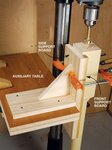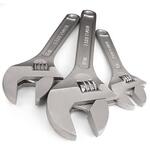We may receive a commission when you use our affiliate links. However, this does not impact our recommendations.
Editor’s note: This is an excerpt from Nancy Hiller’s English Arts & Crafts Furniture: Projects and Techniques for the Modern Maker. You can get your copy at Shop Woodworking. Enjoy!

Many pieces of English Arts & Crafts furniture, especially those of the Cotswolds School, feature a cheerful detail known as decorative gouging. It’s a simple technique and amenable to endless variations depending on the combination of gouges used, the spacing and depth of elements, and so on.
Decorative gouging gains as much of its effect from its context as from the gouging itself. It appears most often on, or near, the edge of a tabletop, leg or gallery rail; the crispness of the edge forms a border that’s integral to the design. In many cases, the gouging is done on a chamfer. In cases where there is no direct edge bordering the carving, such as Christopher Vickers’s reproduction of an Ernest Gimson table, the edge is defined by a routed line.
Gimson’s 1908 drawing indicates chevron inlay on the chamfered sections of the legs and specifies that decorative gouging may be substituted. I decided to go with the gouging because I thought it would look striking in curly sassafras.
Begin by choosing your gouges. Depending on the look you’re after, you may use one gouge or two. Some of the most appealing examples of gouging I have seen are made with an elongated tail, which gives an almost animal-like appearance; the pattern puts me in mind of a school of tropical fish. I did several trials using different combinations of gouges and decided on a 10mm chisel with a #8 sweep for the tails and a 15mm with a #9 sweep for the body.
Figure out the spacing of your pattern based on the gouges you’re going to work with; usually the space between the head of one gouge cut and the tail of the next is roughly equal to the flat border on each side of the gouged area.
Experiment on a piece of scrap to determine the spacing between the gouge cuts and the distance from the defining edges. Once you have your spacing figured out, make a template. Be sure to mark which direction is up, and make a point of paying attention to this each time you lay out a new part; it’s easy to get lost in the process and forget the big picture until it’s too late.


Lay out the edges of your pattern, then use a template to lay out the individual “fish.”
The double lines indicate the spacing between the head of one gouge cut and the tail of the one it’s following.
After you transfer these marks onto your workpiece, mark it to indicate the center. You can either draw a pair of lines at the outside edges of your desired pattern or just one line in the center.

The first step is to chop the fishes’ tails using a gouge and mallet perpendicular to the work.
Define the tails by holding your first gouge perpendicular to the workpiece and chopping straight down. In sassafras, this took two gentle blows of the mallet to get the depth I desired. Don’t worry about getting every cut lined up perfectly. All of the historic examples I’ve seen are slightly imperfect. It’s this subtle variation that gives the pattern life.

Next, use the gouge you’ve selected for the fish bodies and work it through the wood, either with a mallet, or by hand. Either way, finishing up by hand will give you a cleaner cut.
Now get your second gouge, if you’re using two different sizes, and carefully carve out the body of each fish. I tried this with a mallet, then realized I could get a smoother cut by just pushing the gouge through the pattern carefully, rocking it gently from side to side as I moved it through the fibers. I made these cuts in two passes; this allowed me to remove the bulk of the material first, while gauging the character of the grain in an effort to avoid tears.
Once you’ve carved all the legs, move onto the next step: the apron.
 English Arts & Crafts Furniture
English Arts & Crafts Furniture
Projects & Techniques for the Modern Maker
By Nancy R. Hiller
English Arts & Crafts Furniture explores the Arts & Crafts movement with a unique focus on English designers. Through examination of details, techniques, and historical context, as well as projects, you’ll discover what sets these designers and their work apart from those that came before and after, as well as gain a deeper understanding of the Arts & Crafts movement and its influence.
Three complete furniture builds provide a glimpse into the breadth of ideals encompassed by Arts & Crafts:
- Voysey’s two heart chair, with its woven seat and sharp finials, combines simplicity of form with an elegant uprightness
- A striking sideboard design from Harris Lebus, one of England’s largest furniture manufacturers at the turn of the century, was not just imposing, but affordable for a middle-class market
- Gimson’s hayrake table marries rural allusions, challenging joinery, and exuberant hand-carving in a project that is a joy to build
More an expression of social and economic ideals than any specific design aesthetic, the Arts & Crafts movement encompassed a staggering variety of work. This book for woodworkers and furniture aficionado provides fresh perspective into an exciting moment in design history.
Here are some supplies and tools we find essential in our everyday work around the shop. We may receive a commission from sales referred by our links; however, we have carefully selected these products for their usefulness and quality.









